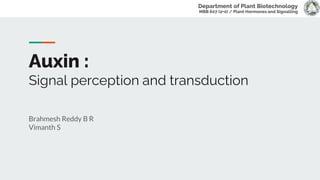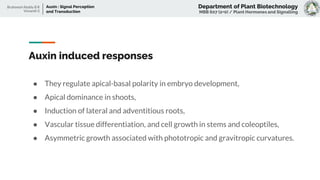AUXIN signal perception and transduction
- 1. Welcome Department of Plant Biotechnology MBB 607 (2+0) / Plant Hormones and Signalling
- 2. Brahmesh Reddy B R Vimanth S Auxin : Signal perception and transduction Department of Plant Biotechnology MBB 607 (2+0) / Plant Hormones and Signalling
- 3. Auxin induced responses ŌŚÅ They regulate apical-basal polarity in embryo development, ŌŚÅ Apical dominance in shoots, ŌŚÅ Induction of lateral and adventitious roots, ŌŚÅ Vascular tissue differentiation, and cell growth in stems and coleoptiles, ŌŚÅ Asymmetric growth associated with phototropic and gravitropic curvatures. Department of Plant Biotechnology MBB 607 (2+0) / Plant Hormones and Signalling Brahmesh Reddy B R Vimanth S Auxin : Signal Perception and Transduction
- 4. General cellular signalling pathway Department of Plant Biotechnology MBB 607 (2+0) / Plant Hormones and Signalling Brahmesh Reddy B R Vimanth S Auxin : Signal Perception and Transduction
- 5. General cellular signalling pathway Ligand is any biomolecule that acts as a intercellular messenger that is synthesised or released in response to the external stimuli Department of Plant Biotechnology MBB 607 (2+0) / Plant Hormones and Signalling Brahmesh Reddy B R Vimanth S Auxin : Signal Perception and Transduction
- 6. General cellular signalling pathway The cellular receptors act as eyes and ears of the cell they are associated with. They are responsible to sensing the ligand molecule and initiating the downstream signalling cascade of events Department of Plant Biotechnology MBB 607 (2+0) / Plant Hormones and Signalling Brahmesh Reddy B R Vimanth S Auxin : Signal Perception and Transduction
- 7. General cellular signalling pathway Department of Plant Biotechnology MBB 607 (2+0) / Plant Hormones and Signalling Brahmesh Reddy B R Vimanth S Auxin : Signal Perception and Transduction After the receptor binds to the ligand, the downstream signalling cascade is activated which is responsible for internalization of the signal.
- 8. General cellular signalling pathway Department of Plant Biotechnology MBB 607 (2+0) / Plant Hormones and Signalling Brahmesh Reddy B R Vimanth S Auxin : Signal Perception and Transduction The internalized signal is later localized through the nuclear transcriptional regulations to elicit a morph
- 9. Department of Plant Biotechnology MBB 607 (2+0) / Plant Hormones and Signalling Brahmesh Reddy B R Vimanth S Auxin : Signal Perception and Transduction one of the most common ways for altering protein activity is the addition of a phosphate group to one or more sites on the protein, a process called phosphorylation. Activation by phosphorylation
- 10. Phosphate groups canŌĆÖt be attached to just any part of a protein. Instead, they are typically linked to one of the three amino acids that have hydroxyl (-OH) groups in their side chains: tyrosine, threonine, and serine. Department of Plant Biotechnology MBB 607 (2+0) / Plant Hormones and Signalling Brahmesh Reddy B R Vimanth S Auxin : Signal Perception and Transduction Activation by phosphorylation
- 11. In general, phosphorylation isnŌĆÖt permanent. To flip proteins back into their non-phosphorylated state, cells have enzymes called phosphatases, which remove a phosphate group from their targets. Inactivation by phosphorylation Department of Plant Biotechnology MBB 607 (2+0) / Plant Hormones and Signalling Brahmesh Reddy B R Vimanth S Auxin : Signal Perception and Transduction
- 12. Department of Plant Biotechnology MBB 607 (2+0) / Plant Hormones and Signalling Brahmesh Reddy B R Vimanth S Auxin : Signal Perception and Transduction Auxin Signalling
- 13. Member components Department of Plant Biotechnology MBB 607 (2+0) / Plant Hormones and Signalling Brahmesh Reddy B R Vimanth S Auxin : Signal Perception and Transduction ŌŚÅ Auxin Response Factors (ARF) Transcription factors ŌŚÅ Auxin Responsive elements (AREs) Promoter sequence of Auxin genes ŌŚÅ Aux/IAA Proteins binding to ARFs Repressor ŌŚÅ TPL - TOPLESS Co-repressor ŌŚÅ SCF-E3 ligase Polyubiquitylation ŌŚÅ 26S proteasomes Ubiquitin mediated protein degradation Auxin signalling
- 14. Department of Plant Biotechnology MBB 607 (2+0) / Plant Hormones and Signalling Brahmesh Reddy B R Vimanth S Auxin : Signal Perception and Transduction
- 15. the promoter sequences of auxin- responsive genes TGTCTC Department of Plant Biotechnology MBB 607 (2+0) / Plant Hormones and Signalling Brahmesh Reddy B R Vimanth S Auxin : Signal Perception and Transduction Auxin responsive element (AuxRE)
- 16. ARFs are transcription factors that contain an amino-terminal B3-like DNA-binding domain, which binds to an auxin-responsive element (ARE; TGTCTC) in the promoter of auxin-response genes in an auxin independent manner Department of Plant Biotechnology MBB 607 (2+0) / Plant Hormones and Signalling Brahmesh Reddy B R Vimanth S Auxin : Signal Perception and Transduction Auxin response factors (ARFs)
- 17. Small (20ŌĆō35 kDa) short-lived nuclear proteins. They function as transcriptional repressors of auxin-responsive gene expression Department of Plant Biotechnology MBB 607 (2+0) / Plant Hormones and Signalling Brahmesh Reddy B R Vimanth S Auxin : Signal Perception and Transduction Aux/IAA repressor
- 18. Domain I (of IV) of Aux/IAA contains one (or more) conserved LXLXL motifs (where L is leucine and X is some other amino acid) that has been demonstrated to be the site of interaction with the transcriptional co-repressor TOPLESS (TPL) Department of Plant Biotechnology MBB 607 (2+0) / Plant Hormones and Signalling Brahmesh Reddy B R Vimanth S Auxin : Signal Perception and Transduction TPL Co-repressor
- 19. FineŌĆ” we have to remove the repressor proteins BUT HOW? Department of Plant Biotechnology MBB 607 (2+0) / Plant Hormones and Signalling Brahmesh Reddy B R Vimanth S Auxin : Signal Perception and Transduction
- 20. A protein complex that is responsible for degrading intracellular proteins that have been tagged for destruction by the addition of ubiquitin. 26S proteasome Department of Plant Biotechnology MBB 607 (2+0) / Plant Hormones and Signalling Brahmesh Reddy B R Vimanth S Auxin : Signal Perception and Transduction
- 21. 26S proteasome Department of Plant Biotechnology MBB 607 (2+0) / Plant Hormones and Signalling Brahmesh Reddy B R Vimanth S Auxin : Signal Perception and Transduction Proteasome 26S, named due to its Svedberg (S) sedimentation coefficient, is formed by a 19S regulatory complex, which recognized proteins targeted to the degradation, and a 20S core particle, which degraded targeted proteins.
- 22. Who identifies our repressor proteins and directs them to this 26s proteosome? Department of Plant Biotechnology MBB 607 (2+0) / Plant Hormones and Signalling Brahmesh Reddy B R Vimanth S Auxin : Signal Perception and Transduction
- 23. A component of the machinery for the ubiquitin-dependent degradation of proteins. F-box proteins recognize specific substrates and, with the help of other subunits of the E3 ubiquitin ligase, deliver them to the E2 ubiquitin-conjugating enzyme F-box protein Department of Plant Biotechnology MBB 607 (2+0) / Plant Hormones and Signalling Brahmesh Reddy B R Vimanth S Auxin : Signal Perception and Transduction
- 24. TIR1 protein assembles into a multi subunit SCF ubiquitin ligase (E3) complex that is found in the nucleus. The F-box interacts directly with the substrate to be ubiquitylated The substrates for SCFTIR1 are the Aux/IAA transcriptional repressors. TIR1 auxin-binding proteins/receptors Department of Plant Biotechnology MBB 607 (2+0) / Plant Hormones and Signalling Brahmesh Reddy B R Vimanth S Auxin : Signal Perception and Transduction
- 25. A multisubunit ubiquitin ligase that consists of SKP1, CUL1 and an F-box protein (TIR1 in this case) that confers substrate specificity SCFTIR1 E3 ubiquitin ligase Department of Plant Biotechnology MBB 607 (2+0) / Plant Hormones and Signalling Brahmesh Reddy B R Vimanth S Auxin : Signal Perception and Transduction
- 26. Department of Plant Biotechnology MBB 607 (2+0) / Plant Hormones and Signalling Brahmesh Reddy B R Vimanth S Auxin : Signal Perception and Transduction
- 27. Department of Plant Biotechnology MBB 607 (2+0) / Plant Hormones and Signalling Brahmesh Reddy B R Vimanth S Auxin : Signal Perception and Transduction F-box protein
- 28. Department of Plant Biotechnology MBB 607 (2+0) / Plant Hormones and Signalling Brahmesh Reddy B R Vimanth S Auxin : Signal Perception and Transduction F-box protein Substrate (repressor)
- 29. Department of Plant Biotechnology MBB 607 (2+0) / Plant Hormones and Signalling Brahmesh Reddy B R Vimanth S Auxin : Signal Perception and Transduction F-box protein Substrate (repressor) Auxin (molecular glue)
- 30. Department of Plant Biotechnology MBB 607 (2+0) / Plant Hormones and Signalling Brahmesh Reddy B R Vimanth S Auxin : Signal Perception and Transduction
- 31. Department of Plant Biotechnology MBB 607 (2+0) / Plant Hormones and Signalling Brahmesh Reddy B R Vimanth S Auxin : Signal Perception and Transduction
- 32. SKP2A S-Phase Kinase-associated Protein 2A mediated auxin signalling Department of Plant Biotechnology MBB 607 (2+0) / Plant Hormones and Signalling Brahmesh Reddy B R Vimanth S Auxin : Signal Perception and Transduction
- 33. SKP2A A cell-cycle F-box protein Department of Plant Biotechnology MBB 607 (2+0) / Plant Hormones and Signalling Brahmesh Reddy B R Vimanth S Auxin : Signal Perception and Transduction SKP2A protein contain an F-box and leucine-rich repeat (LRR) domains SKP2A is a cell cycleŌĆōregulated protein that controls the stability of at least two cell division transcriptional factors, E2FC and DPB Based on the SKP2A expression profile, it is likely that it functions during late S-phase and mitosis
- 34. SKP2A degrades E2FC and DPB ŌŚÅ overexpression of SKP2A increases the number of dividing cells in the meristems, indicating that SKP2A might function in promoting cell-cycle progression ŌŚÅ Cell cycle is strictly controlled in plants, and the degradation of G1-to-S checkpoint regulators, E2FC and dimerization partner of E2FB (DPB), is required for the continuation of the cell cycle ŌŚÅ cell-cycle repressors E2FC and DPB are targeted by the SCFSKP2A for degradation ŌŚÅ SKP2a can bind to auxin which enhances its interaction with E2FC and DPB Department of Plant Biotechnology MBB 607 (2+0) / Plant Hormones and Signalling Brahmesh Reddy B R Vimanth S Auxin : Signal Perception and Transduction
- 35. Department of Plant Biotechnology MBB 607 (2+0) / Plant Hormones and Signalling Brahmesh Reddy B R Vimanth S Auxin : Signal Perception and Transduction
- 36. Department of Plant Biotechnology MBB 607 (2+0) / Plant Hormones and Signalling Brahmesh Reddy B R Vimanth S Auxin : Signal Perception and Transduction https://doi.org/10.1016/j.jgg.2023.07.002
- 37. Department of Plant Biotechnology MBB 607 (2+0) / Plant Hormones and Signalling Brahmesh Reddy B R Vimanth S Auxin : Signal Perception and Transduction
- 38. Department of Plant Biotechnology MBB 607 (2+0) / Plant Hormones and Signalling Brahmesh Reddy B R Vimanth S Auxin : Signal Perception and Transduction
- 39. ABP1 Extracellular auxin receptor Department of Plant Biotechnology MBB 607 (2+0) / Plant Hormones and Signalling Brahmesh Reddy B R Vimanth S Auxin : Signal Perception and Transduction
- 40. ABP1 from Zea mays was the first auxin-binding protein to be extensively characterized, and a proposed auxin receptor. The 22-kDa protein is found predominantly in the lumen of the endoplasmic reticulum (ER), with a small fraction associated with the outer surface of the plasma membrane (PM), which appears to be the site of function. ABP1 auxin-binding proteins/receptors Department of Plant Biotechnology MBB 607 (2+0) / Plant Hormones and Signalling Brahmesh Reddy B R Vimanth S Auxin : Signal Perception and Transduction
- 41. ABP1 is an extracellular auxin receptor ABP1 is not a transmembrane protein; thus, it requires (an) accessory protein(s), which transmits a signal to the cell interior, and at the same time holds ABP1 in place close to the membrane. ABP1 auxin-binding proteins/receptors Department of Plant Biotechnology MBB 607 (2+0) / Plant Hormones and Signalling Brahmesh Reddy B R Vimanth S Auxin : Signal Perception and Transduction
- 42. the best candidate for a docking protein is an extracellular, glycosylphosphatidylinositol (GPI)- anchored protein ABP1 auxin-binding proteins/receptors Department of Plant Biotechnology MBB 607 (2+0) / Plant Hormones and Signalling Brahmesh Reddy B R Vimanth S Auxin : Signal Perception and Transduction
- 43. Lastly, it is speculated that phospholipases might play a role in signalling events downstream of ABP1 ABP1 auxin-binding proteins/receptors Department of Plant Biotechnology MBB 607 (2+0) / Plant Hormones and Signalling Brahmesh Reddy B R Vimanth S Auxin : Signal Perception and Transduction
- 44. Department of Plant Biotechnology MBB 607 (2+0) / Plant Hormones and Signalling Brahmesh Reddy B R Vimanth S Auxin : Signal Perception and Transduction
- 45. Thank you Department of Plant Biotechnology MBB 607 (2+0) / Plant Hormones and Signalling Brahmesh Reddy B R Vimanth S Auxin : Signal Perception and Transduction


















































































